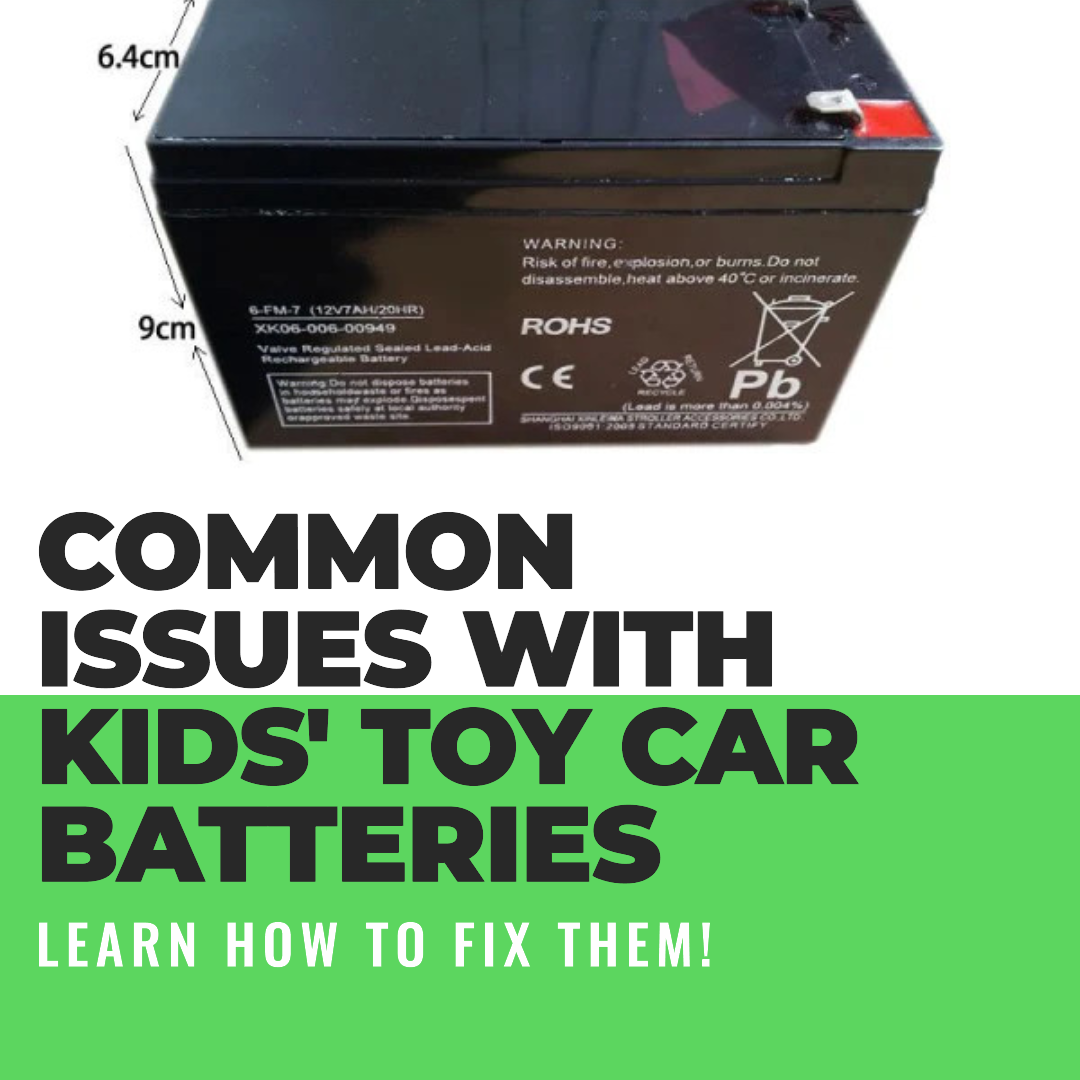Published: June 6, 2023
Updated: March 24, 2025
Is your kid’s toy car not working, and you can’t figure out why? You’re not alone.

This 2025 guide covers common battery issues in kids’ toy cars and simple fixes to get them running again.
Common Issues with Kids’ Toy Car Batteries
Loose or Bad Wires
Loose wires are sneaky culprits—like missing puzzle pieces, they stop the toy car from working.
Rough play or wear can disconnect them. Open the casing, check for loose wires, and reconnect them securely using the manual.
Corrosion on Terminals
Corrosion is like plaque on teeth—it builds up and blocks power. It happens when battery acid reacts with metal terminals.
Clean it off with a wire brush or sandpaper, being careful not to damage the terminal. This restores smooth power flow.
Dead Battery
A dead battery halts playtime—like a car out of gas. It might be old, overused, or faulty.
Recharge if possible, but if it won’t hold a charge, replace it with a new one. See Toy Car Battery Lifespan.
Broken Switches or Connectors
Switches and connectors are the toy car’s relay team, passing power to the motor. If broken, they’re like a faulty light switch—nothing works.
Wear, drops, or defects can cause this. Replace the damaged part to get the car moving again.
Tight Wheel Retainers
Overly tight wheel retainers restrict movement—like running in tight shoes. They stop wheels from turning freely.
Loosen them just enough for smooth rotation while keeping wheels secure. It’s all about balance.
Motor Problems
The motor is the toy car’s heart. If it fails—due to overuse or damage—the car stops, like a heart needing a jumpstart.
Test with a direct battery connection. If it doesn’t respond, replace the motor to revive the car.
Choosing the Right Battery
Battery Types
- Lead-Acid: Affordable, steady power for larger toys.
- Lithium-Ion: Lighter, longer-lasting, great for high-end models.
- NiMH: Balanced cost and performance, eco-friendly.
Match the voltage (e.g., 6V or 12V) to avoid damage. See Maximize Your Battery.
Signs of Motor Failure
Warning Signs
- Strange noises (grinding, squealing).
- Slower speed despite a charged battery.
- Intermittent stops or overheating.
Test by timing a 10-meter run—compare to the car’s original speed. If it’s sluggish, the motor may need replacing.
Step-by-Step Guide to Testing a Battery with a Multimeter
- Set Up: Switch your multimeter to DC voltage (6V or 12V range).
- Find Terminals: Positive (+) is often red, negative (-) is black.
- Measure: Red probe to positive, black to negative—check the reading.
- Interpret: 6V battery should read 6.2V+; 12V should be 12.6V+. Below 5.5V (6V) or 11.8V (12V) means recharge or replace.
Safety Tip: Handle batteries carefully, keeping them away from kids during testing.
Related: Toy Car Battery Lifespan
Diagnosing and Fixing Issues
Get a Volt Multimeter
A volt multimeter is your toy car’s doctor—like a stethoscope for electronics. It measures voltage and current to spot issues.
Buy one at hardware stores or online. Pick a user-friendly model with a digital display and clear instructions.
Fixing the Problems
- Loose Wires: Reconnect securely using the manual.
- Corrosion: Scrub terminals with a wire brush. See Cleaning Terminals.
- Dead Battery: Replace with a new one—find replacements here.
- Broken Switches: Swap out faulty switches or connectors.
- Tight Retainers: Loosen for free wheel movement.
- Motor Failure: Replace if it doesn’t respond to a direct connection.
Prevention Tips
- Check monthly for loose parts or corrosion.
- Charge properly—don’t overcharge or fully drain.
- Clean with a soft cloth; store in a cool, dry place.
More tips: Maintaining Ride-On Cars.
Storing Toy Cars Safely
Best Practices
- Clean thoroughly and dry before storing.
- Remove the battery; store at 50% charge in a cool place.
- Keep in a dry spot, off the ground, with a breathable cover.
- Check monthly—rotate wheels to avoid flat spots.
Conclusion
Fixing toy car battery issues is easier than it looks. With these tips, you’ll keep your kid’s car running for endless fun in 2025!
FAQs
How often should I check the battery?
Monthly—like a car check-up—to catch issues early.
What cleans battery terminals?
A wire brush or sandpaper removes corrosion effectively.
When to replace the motor?
If it doesn’t start with a direct battery connection, it’s likely done.
Where to buy a multimeter?
Hardware stores or online—look for a beginner-friendly model.
Can I prevent tight wheel retainers?
Yes, adjust them to balance security and free movement.
Ready to Ride? 🚀
Loved “Common Issues with Kids’ Toy Car Batteries?” Want more tips?
Visit RiiRoo.com or chat live with us for ride-on fun!





Share:
Understanding the Lifespan of Kids' Toy Car Batteries
Understanding Your Ride-On Car's Charging Process